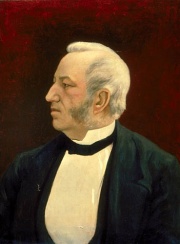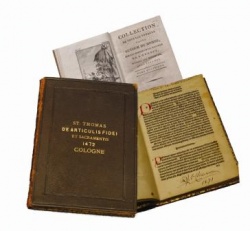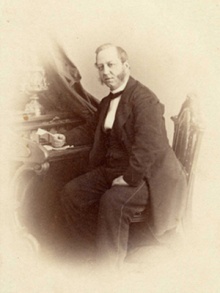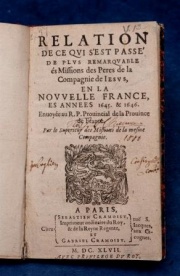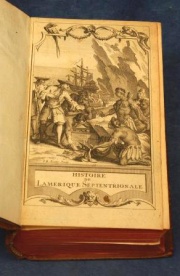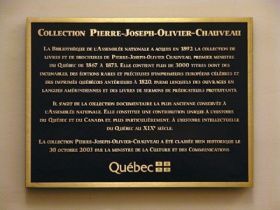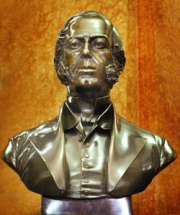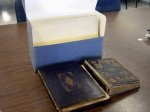Chauveau Collection
par Bernier, Gaston
The Chauveau Collection is not only a priceless testament to intellectual life in the 19thcentury, but also to one of the era's outstanding academic figures, as well as to the establishment of one of the first public libraries in the Province of Quebec. Very few of Quebec's historic libraries and collections are classified as heritage treasures. In fact, the collection assembled during the 19th century by Premier Pierre-Joseph-Olivier Chauveau was the first to be granted heritage status (including all of the obligations that such a status entails: i.e. preserving the collections original condition; maintaining it in good condition; limiting collection circulation to the Province of Quebec, unless otherwise permitted by the government; and ensuring that it remains the non-transferrable property of under the protection of the state.
Article disponible en français : Collection Chauveau
The Collection
As of September 2005, the collection assembled by Chauveau during his lifetime included 3,715 written works representing 3,025 different titles.(NOTE 1) Among the works are 1,596 texts and 1,429 volumes. There are considerably more volumes in the collection from the more recent periods of history. For 6 volumes from the collection date from the 15th century, 35 from the 16th century, 79 from the 17th century, 154 from the 18th century, and 2,751 from Chauveau's own century (the 19th). Most of Chauveau's books and pamphlets (1,846 of them, to be exact) are in French. There are also 1,038 volumes written in English, 100 in Latin, 16 in Native languages, 12 in Greek and 13 in various European languages.
Chauveau's library began, and still remains as, an encyclopaedic library. In 1892, Narcisse-Eutrope Dionne categorized its contents as follows: "European works", "Journals and magazines (politics, law and sciences)", "Americana", "Canadian history" and "Canadian works." More recently, during an exhibit of the collection's books, seven themes were selected: education, magazines and journals, history and politics, rare and very old books, legal and judicial articles of law, literature, and religion.(NOTE 2)
The size and scope of the Chauveau library was more impressive in 1892, than it was following the 2005 inventory. The library report included in the Débats de l'Assembée Législative [Debates of the Legislative Assembly] and the Votes and Proceedings from the National Assembly of Quebec for January 13, 1893 spoke of 3,512 volumes, 1,750 pamphlets that had been bound into volumes, 750 works kept in boxes, and 711 "various pamphlets." After being made available to the general public for more than a century, the entire collection was reduced to less than half its original size. Some titles were lost and others disposed of due to their poor condition or very insignificant documentary value. Nevertheless, a number of titles deemed precious by the then‑resident librarian managed to withstand the ravages of time, and so, 221 of 233 titles still remained at the time of sale of the collection.(NOTE 3)
Pierre-Joseph-Olivier, a Collector for the Humanities
On many levels, Chauveau's bibliographical legacy-in the words the collection's curator of 27 years-is not only "a priceless treasure," but also a testimony to the past.
In and of itself, the collection epitomizes a 19th-century intellectual and humanist's library. According to those who personally knew or studied Chauveau, he was interested in almost every field of study and he sought enlightenment concerning them all. For some, the library offers a well thought out, coordinated whole that reveals the refined tastes of a true bibliophile. For others, it remains "one of Quebec's richest private libraries to have been assembled in the 19th century [...] a true reflection of the outstanding and eclectic nature of the man himself, it is composed of works from a number of countries and dealing with subjects that are as many and varied as they are interesting."(NOTE 4) In an archive memo dated October 2003, the Quebec Ministère de la Culture et Communications made the following observation: "The collection [...] includes precious editions from celebrated European printers, books dating from the 15th and 16th centuries, and some very old Canadian books. The collection is remarkable for its scope and the rarity of the items. It represents an important contribution to the history of Quebec and Canada, particularly the intellectual history of 19th-century Quebec." In fact, the works from Quebec are reflective of the thinking of the era and the numerous foreign, mostly French and British volumes are indicative of Quebec's early interactions with the outside world.
During a reception held on March 16th, 2004 to mark the completion of the archiving process, the collection's historian and librarian, Gilles Gallichan, gave a presentation, in which he focused on the collection's most precious selection of printed material. The selection included St. Thomas Aquinas's Summa Theologica, printed in Venice in 1473; the Jesuit Relations; the works of Marie de l'Incarnation; the history of New France written by Father Charlevoix; as well as numerous first editions from some of the greatest 16th- and 17th-century Italian, French, Swiss and Belgian printers.
The collection that has been amassed is a bibliographical treasure that demonstrates how both citizens and libraries acquire their reading selections. For example, it is quite clear that Chauveau invested considerable effort and creativity, in order to assemble and develop his collection. When he was only 16 years old, he entrusted Father Holmes, a priest who was one of his teachers at the Séminaire de Québec with his savings, along with a list of volumes to be purchased in Europe. Throughout his entire life, he not only put together a vast network of correspondents from political and literary circles, but he also attended private sales, made exchanges, made frequent visits to second-hand bookstores (NOTE 5) and subscribed to second-hand-book catalogues.(NOTE 6)
Acquisition and Incorporation: the Collection goes to the Parliamentary Library
The 1892 purchase of the collection by the Bibliothèque des Parlementaires [the library that is today kept by Quebec's Assemblée Nationale] was very much in keeping with a typical practice of the day. For, in 1888, various buyers had acquired Judge Antoine Polette's library and prior to that John Fleming's (1843), Judge John Fletcher's (1845) and Dr. Edward Bailey O'Callaghan's (1883). Later, such acquisitions would be repeated again in 1893 (Léon Provencher) and in 1897 (Théodore Robitaille). All in all, such practices were commonly a means used by private individuals and public institutions to overcome not only the book distribution system's inadequacies, but also the slowness of the mail and the shortage of major bookstores.
Although the first chapter in the existence of the Chauveau library closed with the passing of its creator, a new one would continue as it became available to the public. In his will(NOTE 7), which was written in 1884, Chauveau made his collection available for purchase. In the first instance, it would be sold to Laval University for $7,000, but if the institution refused to buy it, it would then be offered to Quebec's Parliamentary Library for $8,000.(NOTE 8) The University refused and so the collection passed into the hands of the government institution. Neither was the university's refusal to purchase the books and pamphlets ever explained,(NOTE 9) nor was the higher sum demanded of the government.(NOTE 10)
The sale of the collection occurred seven years after a fire had raged through parliament and its library. During a parliamentary session held in the National Assembly on December 30th, 1890, two members of parliament, Adélard Turgeon (a Liberal minister from Bellechasse) and Jean Blanchet (the Conservative opposition leader) described the collection in glowing terms and proposed that it be purchased and integrated into the "nation's library"(NOTE 11) Then another liberal minister, Charles Langelier took the floor and revealed that the government was already intending to acquire the collection.
In the end, the fate of the library was decided in a manner that was totally different from how everyone had originally imagined it, For although, according to Langlier, the politicians had intended to "make it into separate (un-integrated) collection," N.-E. Dionne claimed that, due to the fact that the parliamentary library was trying to accelerate collection restoration efforts following the 1883 fire(NOTE 12) (only 4,500 of its 30,000 volumes had been saved), much of the newly acquired Chaveau Collection was to be catalogued and put in the regular stacks. The Canadiana and historical volumes were to be kept in the office of the curator and the most precious works were supposed to be put away under lock and key. Twenty-five years later, however, it became clear that all the volumes and pamphlets of the collection had actually been catalogued according to subject matter and shelved in the regular stacks.(NOTE 13) And so, the precious volumes of Chauveau's collection suffered the usual fate reserved for books made available to the general public-they suffered the ravages of time, becoming worn, torn, lost, culled during inventories and undergoing hodgepodge repairs and re-binding. Sensing disaster, Lucien Lemieux, a parliamentary employee in 1938, proposed that the collection-which "the classification process had dispersed"-be re-assembled. (NOTE 14) Nevertheless, the volumes were not actually removed from the public-reading section until around the beginning of the 1990s, when they were placed in a vault constructed especially to protect them.
Recognizing and Promoting the Collection
The Government of Quebec's official recognition of the Chauveau Library in 2003 finally rewarded the numerous efforts that various individuals had made over the decades to ensure the collection would be preserved and given a place of honour for posterity.(NOTE 15) To this end, officials settled on the idea of a separate collection that would have its own bibliographical catalogue. The collections various individual pamphlets would be artificially bound together; a special exhibit would be held; sufficient funds would be set aside from the 2000-01 budget for restoring deteriorating volumes; the pamphlets would be microfilmed; and a procedure for recovering misplaced or lost volumes would be established.
The first initiative to promote the collection came in the form of a catalogue.(NOTE 16) Chauveau himself had kept three updated ledgers(NOTE 17) of his volumes, but the selection recorded by Chaveau did not necessarily correspond to the collection that was entrusted to the care of the Parliamentary Library.(NOTE 18) The first inventory of the collection was completed by Dionne in 1892 and thereafter it was made available to the library's readership.(NOTE 19) This inventory was followed up by seven articles published in the Courrier du Livre (during the 2nd year: 1897-98). Over the century that followed, notes concerning Chauveau's volumes and pamphlets were recorded in the series of catalogues published up until 1935 and then subseqeuntly, in the library's own catalogues. The first scientific inventory was undertaken during the 1970s, just after the decision to reassemble the collection was handed down. In 2000, the first edition of the inventory was published and an updated version in 2005. By that time both the 2000 catalogue and the manuscript catalogues were already available on-line.
Parliamentary leaders and librarians have made every effort to promote the collection. They organised two exhibits, one in 1978(NOTE 20) and another during 2005-2006. Furthermore, an event was held on March 16th, 2004 to mark the corpus's official recognition as a National Cultural Asset. To commemorate this, a plaque was unveiled and, during another event on November 2nd, 2005 a bust of Chauveau was unveiled. During the latter event, all those owning volumes that had previously belonged to Chauveau were invited to donate them to the collection.(NOTE 21) Last but not least, the public-awareness campaign also included the distribution of promotional brochures and the publication of several articles on the collection.
The Historical Account of an Outstanding Public Figure
The Chauveau Collection is the historical legacy of a private library assembled by a distinguished Quebecker. It is a documentary resource of considerable significance for Quebec's parliamentary institutions as well as for the population in general. As for the latter, it should be remembered that in Quebec it was Chaveau that founded both the private library and the Bibliothèque du Département de l'Instruction Publique [Library of Public Education], which was eventually joined by the Bibliothèque de la Représentation Nationale [a library for the members of the National Assembly], the success of which was also the fruit of Chaveau's efforts. Chaveau was also responsible for recruiting Pamphile Le May and allocating resources for the endeavours. Today, due to the age and state of the various volumes of the collection, they are protected from daily wear and tear. And so, although the volumes are very descriptive, they are not available for regular use. Besides, most of the information is generally out of date. Nevertheless the collection offers a glimpse into the scientific, religious and political thinking of the period in which they were assembled, as well as revealing some of the ideas of previous centuries. Furthermore, the collection deserves recognition for additional reasons still: for it is a tribute to a writer, a politician and an administrator who left his mark on his era.(NOTE 22) Not only does the collection reveal much about Chaveau himself,(NOTE 23), but it is also "one of the richest private libraries assembled during the 19th century."(NOTE 24) It also serves to illustrate just how small-as well as large-scale-the collecting efforts of bibliophiles and institutional libraries of era could be, as they sought to acquire ever more comprehensive collections.
Gaston
Bernier
Director
of the Bibliothèque de l'Assemblée Nationale (parliamentary librarian,
1994-2000)
L'Assemblée Nationale du Quebec
NOTES
Note 1: Figures presented in this paragraph have been taken from the Inventaire du fonds Chauveau de la Bibliothèque de l'Assemblée nationale [The Parliamentary Library Inventory of the Chauveau Collection] carried out by Clément Lebel (2005), p. i, v and vi.
Note 2: Martin Pelletier, "Entre savoir et pouvoir: la collection de Pierre-Joseph-Olivier Chauveau, bibliophile et premier ministre," Bulletin de la Bibliothèque de l'Assemblée nationale, Vol. 35, No. 4, octobre 2006, p. 25-30.
Note 3: Inventaire du fonds Chauveau, p. v.
Note 4: Louis-Philippe Ferron, Au fil des pages; la Bibliothèque de l'Assemblée nationale [...] (Bibliographie et documentation, 44; Québec City, la Bibliothèque, 2002), p. 13. [Original citation translated into English]
Note 5: Louis-Philippe Ferron, p. 18, 32.
Note 6: Particularly those of Philéas Gagnon (Daniel Olivier, in Documentation et bibliothèques, Vol. 25, No. 4, décembre 1979, p. 208).
Note 7: Published in full in Rapport des archives du Québec, tome 41, 1960-61, Québec, Imprimeur de la Reine, 1963, p. 168-174.
Note 8: Amount approved by vote by the Quebec National Assembly in 1890 and paid to the [Chaveau] estate on May 12th, 1892 (Journaux, 1893-94, p. 300).
Note 9: A reporter from the Courrier du Canada (July 11th, 1890) wrote: "[...] Université Laval [...] does not wish to deprive the heirs of the benefits of the higher price that they can obtain from the government." [Original citation translated into English]
Note 10: Perhaps there was a touch of bitterness resulting from the "forced" 1875 integration of the Bibliothèque de l'Instruction Publique [Library of Public Education] (also founded by Chaveau) into the Parliamentary Library that had recently been destroyed by fire in 1883. Chauveau had fiercely opposed the merger in 1869 and in 1872 (see Hélène Sabourin, À l'école de P.J.O. Chauveau, Montréal, Léméac, 2003), p. 179-180.
Note 11: Débats 1890-1892, p. 557-559.
Note 12: The three elected representatives who took the floor on December 30th, 1890 all invoked the catastrophe of 1883 to justify purchasing the library (see Martin Pelletier, loc. cit.). Newspapers of the era (Le Canadien, December 4th, 1890 and particularly the Courrier du Canada, December 30th, 1890) and a contemporary expert, Napoléon Legendre also cited the same reasons (Session documents, 1890-92, No. 125). In fact, the parliamentary library's collection grew considerably (from 33,804 to 44,590 volumes) in less than two years (from April 28th, 1892 to November 9th, 1893).
Note 13: Rapport annuel du bibliothécaire [Librarian's Annual Report], 1918-1919, p. 12.
Note 14: Letter dated February 3rd, 1938. Archives de l'Assemblée nationale. Fonds Lemieux, P17, S2.
Note 15: The Bibliothèque de l'Homme Politique Québécois [Quebec's Politician's Library] obtained its current national status on October 30th, 2003, when Quebec's Minister of Culture and Communications signed an act granting the institution official recognition (Cultural Property Register, File 11-390). The proposal itself had been forwarded to the ministry in May 1999 by the administration of the National Assembly, with the intent of using the status to commemorate the passage from one millennium to another. The process took more time than expected and was not completed in time for the Parliamentary Library's bi-centennial, celebrated in 2002 from March to October. The completion of the classification endeavour was announced in a notice issued during the month of November, and the Office of the National Assembly officially accepted the proposal, which was retroactively applied to November 14th, 2002,10 months later (Décision 1159, 11 séptembre, 2003),.
Note 16: The most authoratitive text on the subject is Clément Lebel's introduction in Inventaire du fonds Chauveau de la Bibliothèque de l'Assemblée nationale, p. i-vii.
Note 17: Catalogue de ma bibliothèque [...] (circa 1854); Collection de pamphlets, brochures, documents et autres publications (1861-86?); Mes livres rares (1873? 3 notebooks).
Note 18: Owing to financial difficulties, Chauveau had to sell certain volumes to McGill University around 1876 (Jean Hamelin and Pierre Poulin, "Chauveau," Dictionary of Canadian Biography, vol. XI, p. 203).
Note 19: Rapport annuel du bibliothécaire, 1918-19, p. 12.
Note 20: Pierre-Joseph-Olivier Chauveau Collection [...]; exposition [at the] Bibliothèque de l'Assemblée nationale [Library of the National Assembly] [...], 1978.
Note 21: Two gifts were made by Chaveau's descendants, the first by Marie Sénécal (Guide de Versailles; Imitation de Jésus-Christ) in June of 2000, and the second by Charles Robert (Œuvres de Racine, in five volumes) in the fall of 2005.
Note 22: Chauveau has been the subject of many biographies. Among others, see Marcel Hamelin and Pierre Poulin, in Dictionary of Canadian Biography vol. 11, Quebec, Presses de l'Université Laval, 1982, 194-204; Gilles Gallichan, "Pierre-Joseph-Olivier Chauveau: portrait [...]," Histoire Québec, vol. 12, No. 2, 2006, p. 24-30; ibid., "Chauveau: homme d'État, homme de lettres," Bulletin de la Bibliothèque de l'Assemblée nationale, vol. 19, No. 1-2, mai 1990, p. 7-9.
Note 23: "[...it is] a personal collection [...which] is an extraordinary testimony to the tastes and ideas of its owner [...] a self-confession" (Alphonse Dupront as quoted by Gilles Gallichan, March 16th, 2004, and translated into English for this text).
Note 24: Louis-Philippe Ferron, loc. cit., p. 13. The amount paid for the purchase of the collection can be considered an indication of its value. In 1892, $8,000 represented the equivalent of the parliamentary library's entire operating budget and four times the funds allocated for the purchasing of selections to be added to the library's stacks. In early 21st-century terms, this is the equivalent of a one to four million-dollar expenditure.
« Achat de la bibliothèque de P.J.O Chauveau », Débats de l'Assemblée législative, 30 décembre 1890, p. 557-559.
Dionne, Narcisse-Eutrope, « La Bibliothèque de la Législature : le Fonds Chauveau », Courrier du livre, 2e année, 1897-1898, p. 7-10, 33-41, 65-73, 109-115, 135-142, 163-177, 195-203.
Ferron, Louis-Philippe, « Pierre-Joseph-Olivier Chauveau et sa bibliothèque », dans Gallichan, Gilles (dir.), Au fil des pages et du temps; La Bibliothèque de l'Assemblée nationale, deux siècles d'histoire, Québec, la Bibliothèque, n°43, 2002, p. 13-33.
Lebel, Clément, Inventaire du fonds Chauveau de la Bibliothèque de l'Assemblée nationale, Québec, la Bibliothèque, vii, 2000 (2005), 399 p.
Pelletier, Martin, « Entre savoir et pouvoir : la collection de Pierre-Joseph-Olivier Chauveau, bibliophile et premier ministre », Bulletin de la Bibliothèque de l'Assemblée nationale, n°4, vol. 35, octobre 2006, p. 25-30.
Additional DocumentsSome documents require an additional plugin to be consulted
Images
-
 Marie-Louise-Flore Ma
Marie-Louise-Flore Ma
sse (Madame Pie... -
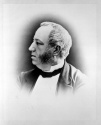 Monsieur Pierre-Josep
Monsieur Pierre-Josep
h-Olivier Chauv... -
 Pierre-Joseph-Olivier
Pierre-Joseph-Olivier
Chauveau -
Pierre-Joseph-Olivier
Chauveau

